Study on the Relationship between Urban Street-Greenery Rate and Land Surface Temperature Considering Local Climate Zone
Abstract
1. Introduction
2. Materials and Methods
2.1. Study Area
2.2. Data Sources
2.3. Methods
2.3.1. Retrieval of LST
2.3.2. Calculation of SGR
2.3.3. Classification of Street Types
2.3.4. Correlation Analysis
3. Results
3.1. Spatial Characteristic of LST Result
3.2. Spatial Distribution Map of Streets LST
3.3. Spatial Distribution of SGR
3.4. Spatial Distribution of Different Street Types
4. Discussion
4.1. Validation of SGR Calculation Results
4.2. Relationship Exploration between Streets’ SGR and LST
4.3. Policy Implications and Limitations
5. Conclusions
Author Contributions
Funding
Institutional Review Board Statement
Informed Consent Statement
Data Availability Statement
Acknowledgments
Conflicts of Interest
Abbreviations
| LCZ | Local climate zone | A term for describing regional local climate |
| LST | Land surface temperature | An index for describing regional surface temperature |
| SGR | Street-greenery rate | An index for describing the street greenery rate |
References
- Wen, Q.; Zhang, Z.; Shi, L.; Zhao, X.; Liu, F.; Xu, J.; Yi, L.; Liu, B.; Wang, X.; Zuo, L.; et al. Extraction of basic trends of urban expansion in China over past 40 years from satellite images. Chin. Geogr. Sci. 2016, 26, 129–142. [Google Scholar] [CrossRef]
- National Bureau of Statistics of the People’s Republic of China. China Statistical Yearbook; China Statistics Press: Beijing, China, 2022. [Google Scholar]
- United Nations, Department of Economic and Social Affairs, Population Division. World Urbanization Prospects: The 2018 Revision; United Nations, Department of Economic and Social Affairs, Population Division: New York City, NY, USA, 2018. [Google Scholar]
- Ahmed, G.; Zan, M.; Kasimu, A. Spatio-Temporal Changes and Influencing Factors of Surface Temperature in Urumqi City Based on Multi-Source Data. Environ. Eng. Sci. 2022, 39, 928–939. [Google Scholar] [CrossRef]
- Morshed, M.; Chakraborty, T.; Mazumder, T. Measuring Dhaka’s urban transformation using nighttime light data. J. Geovis. Spat. Anal. 2022, 6, 25. [Google Scholar] [CrossRef]
- Zhang, W.; Li, Y.; Zheng, C.; Zhu, Y. Surface urban heat island effect and its driving factors for all the cities in China: Based on a new batch processing method. Ecol. Indic. 2023, 146, 109818. [Google Scholar] [CrossRef]
- Badugu, A.; Arunab, K.S.; Mathew, A.; Sarwesh, P. Spatial and temporal analysis of urban heat island effect over Tiruchirappalli city using geospatial technuques. Geod. Geodyn. 2022, in press. [CrossRef]
- Feng, R.; Wang, F.; Liu, S.; Qi, W.; Zhao, Y.; Wang, Y. How urban ecological land affects resident heat exposure: Evidence from the mega-urban agglomeration in China. Landsc. Urban Plan. 2023, 231, 104643. [Google Scholar] [CrossRef]
- Li, H.; Zhou, W.; Wang, W.; Zheng, Z. Imbalanced supply and demand of temperature regulation service provided by urban forests: A case study in Shenzhen, China. Ecol. Indic. 2022, 145, 109666. [Google Scholar] [CrossRef]
- Li, X.; Zhang, C.; Li, W.; Ricard, R.; Meng, Q.; Zhang, W. Assessing street-level urban greenery using Google Street View and a modified green view index. Urban For. Urban Green. 2015, 14, 675–685. [Google Scholar] [CrossRef]
- Xiao, L.; Wang, W.; Ren, Z.; Fu, Y.; Lv, H.; He, X. Two-city street-view greenery variations and association with forest attributes and landscape metrics in NE China. Landsc. Ecol. 2021, 36, 1261–1280. [Google Scholar] [CrossRef]
- Souverijns, N.; Ridder, K.; Veldeman, N.; Lefebre, F.; Kusambiza-Kiingi, F.; Memela, W.; Jones, N. Urban heat in Johannesbrug and Ekurhuleni, South Africa: A meter-scale assessment and vulnerability analysis. Urban Clim. 2022, 46, 101331. [Google Scholar] [CrossRef]
- Xu, X.; Pei, H.; Wang, C.; Xu, Q.; Xie, H.; Jin, Y.; Feng, Y.; Tong, X.; Xiao, C. Long-term analysis of the urban heat island effect using multisource Landsat images considering inter-class differences in land surface temperature products. Sci. Total Environ. 2023, 858, 159777. [Google Scholar] [CrossRef]
- Wang, Z.; Zhang, A.; Liu, M. Daily Spatial Distribution of Apparent Temperature Comfort Zone in China Based on Heat Index. Remote Sens. 2022, 14, 4999. [Google Scholar] [CrossRef]
- Huang, Y.; Sun, Y. Judgement Characteristics and Quantitative Index of Suitable Block Scale. J. South China Uni. Technol. 2012, 40, 131–138. [Google Scholar]
- Jin, J. Research of Three-Dimensional Numerical Simulation of Outdoor Thermal Environment on Block-Scale. Zhejiang University. 2010. Available online: https://kns.cnki.net/KCMS/detail/detail.aspx?dbname=CMFD2010&filename=2010125235.nh (accessed on 1 March 2020).
- Du, X. Study on Design Strategy for Thermal Environments of Living Street Canyons in Guangzhou. South China University of Technology. 2014. Available online: https://kns.cnki.net/KCMS/detail/detail.aspx?dbname=CMFD201501&filename=1014063622.nh (accessed on 1 March 2020).
- Zhou, W.; Tian, Y. Effects of urban three-dimensional morphology on thermal environment: A review. Acta Ecol. Sin. 2020, 40, 416–427. [Google Scholar]
- Ding, W.; Hu, Y.; Dou, P. Study on Interrelationship between Urban Pattern and Urban Microclimate. Agchit. J. 2012, 7, 16–21. [Google Scholar]
- Steemers, K. Energy and the city: Density, buildings and transport. Energy Build. 2003, 35, 3–14. [Google Scholar] [CrossRef]
- Cao, A. Road Type of Remote Sensing and the Simulation Analysis of the Impact of Urban Thermal Environment. South China University of Technology. 2016. Available online: https://kns.cnki.net/KCMS/detail/detail.aspx?dbname=CMFD201701&filename=1016771415.nh (accessed on 1 March 2020).
- Ali-Toudert, F.; Mayer, H. Effects of asymmetry, galleries, overhanging facades and vegetation on thermal comfort in urban street canyons. Sol. Energy 2006, 81, 742–754. [Google Scholar] [CrossRef]
- Bourbia, F.; Awbi, H.B. Building cluster and shading in urban canyon for hot dry climate. Renew. Energy 2004, 29, 291–301. [Google Scholar] [CrossRef]
- Daniel, C.; Mathew, S.; Subbarayan, S. GIS-based study on the association between road centrality and socio-demographic parameters: A case study. J. Geovis. Spat. Anal. 2022, 6, 1–12. [Google Scholar] [CrossRef]
- Wu, L. Research on Urban Road Green Space Design Based on the Green Looking Ratio. Shanghai Jiaotong University. 2008. Available online: https://kns.cnki.net/KCMS/detail/detail.aspx?dbname=CMFD2008&filename=2008054618.nh (accessed on 1 March 2020).
- Zhao, S.; Liang, Q.; Zhou, X.; Su, B. Application of Green Looking Ratio in Urban Road Greenland Design. Chin. Hortic. Abstr. 2010, 7, 97–99. [Google Scholar]
- Feng, S.; Wei, Y.; Wang, Z.; Yu, X. Pedestrian-view urban street vegetation monitoring using Baidu Street View images. Chin. J. Plant Ecol. 2020, 44, 205–213. [Google Scholar] [CrossRef]
- Xu, B.; Yang, F.; Li, L. On Green Vision Rate of Road in Old Town of Zhengzhou City Based on Image Recognition. J. Southwest China N. Univ. 2020, 45, 113–119. [Google Scholar]
- Hu, P. Study on Urban Heat Island in the Central City of Chengdu Based on Landsat 8. Chengdu University of Technology. 2015. Available online: https://kns.cnki.net/KCMS/detail/detail.aspx?dbname=CMFD201601&filename=1015312188.nh (accessed on 1 March 2020).
- Li, F.; Ma, A.; Ding, Y.; Yang, J.; Jiao, J.; Liu, L. Research on Urban Heat Island Effect Based on Landsat Data. Remote Sens. Technol. Appl. 2009, 24, 553–558. [Google Scholar]
- Zhang, Z.; He, G.; Wang, M.; Long, T.; Wang, G.; Zhang, X.; Jiao, W. Towards an operational method for land surface temperature retrieval from Landsat 8 data. Remote Sens. Lett. 2016, 7, 279–288. [Google Scholar] [CrossRef]
- Li, S.; Wang, J.; Li, D.; Ran, Z.; Yang, B. Evaluation of Landsat 8-like Land Surface Temperature by Fusing Landsat 8 and MODIS Land Surface Temperature Product. Processes 2021, 9, 2262. [Google Scholar] [CrossRef]
- Zhu, X.; Duan, S.; Li, Z.; Wu, P.; Wu, H.; Zhao, W.; Qian, Y. Reconstruction of land surface temperature under cloudy conditions from Landsat 8 data using annual temperature cycle model. Remote Sens. Environ. 2022, 281, 113261. [Google Scholar] [CrossRef]
- Fu, Y.; Guo, Q.; Wu, X.; He, C.; Sang, X.; Xie, T. A modified model of surface temperature inversion based on Landsat 8 remote-sensing data and measured data. Int. J. Remote Sens. 2018, 39, 6170–6181. [Google Scholar] [CrossRef]
- Onačillová, K.; Gallay, M.; Paluba, D.; Péliová, A.; Tokarčík, O.; Laubertová, D. Combining Landsat 8 and Sentinel-2 Data in Google Earth Engine to Derive Higher Resolution Land Surface Temperature Maps in Urban Environment. Remote Sens. 2022, 14, 4076. [Google Scholar] [CrossRef]
- Meng, X.; Cheng, J. Evaluating Eight Global Reanalysis Products for Atmospheric Correction of Thermal Infrared Sensor—Application to Landsat 8 TIRS10 Data. Remote Sens. 2018, 10, 474. [Google Scholar] [CrossRef]
- Guo, Y.; Zhang, C. Analysis of Driving Force and Driving Mechanism of the Spatial Change of LST Based on Landsat 8. J. Indian Soc. Remote 2022, 50, 1787–1801. [Google Scholar] [CrossRef]
- Sekertekin, A.; Bonafoni, S. Sensitivity Analysis and Validation of Daytime and Nighttime Land Surface Temperature Retrievals from Landsat 8 Using Different Algorithms and Emissivity Models. Remote Sens. 2020, 12, 2776. [Google Scholar] [CrossRef]
- García, D. Analysis and precision of the Terrestrial Surface Temperature using Landsat 8 and Sentinel 3 images: Study applied to the city of Granada (Spain). Sustain. Cities Soc. 2021, 71, 102980. [Google Scholar] [CrossRef]
- Digavinti, J.; Manikiam, B. Satellite monitoring of forest fire impact and regeneration using NDVI and LST. J. Appl. Remote Sens. 2021, 15, 042412. [Google Scholar] [CrossRef]
- Darge, Y.; Hailu, B.; Muluneh, A.; Kidane, T. Detection of geothermal anomalies using Landsat 8 TIRS data in Tulu Moye geothermal prospect, Main Ethiopian Rift. Int. J. Appl. Earth Obs. 2019, 74, 16–26. [Google Scholar] [CrossRef]
- Chen, S.; Wang, T. Comparison Analyses of Equal Interval Method and Mean-standard Deviation Method Used to Delimitate Urban Heat Island. J. Geo-Inf. Sci. 2009, 11, 145–150. [Google Scholar] [CrossRef]
- Hinton, G.; Salakhutdinov, R. Reducing the dimensionality of data with neural networks. Science 2006, 313, 504–507. [Google Scholar] [CrossRef]
- Tian, X.; Wang, L.; Ding, Q. Review of image semantic segmentation based on deep learning. J. Softw. 2019, 30, 440–468. [Google Scholar]
- Song, J.; Du, S.; Feng, X.; Guo, L. The relationships between landscape compositions and land surface temperature: Quantifying their resolution sensitivity with spatial regression models. Landsc. Urban Plan. 2014, 123, 145–157. [Google Scholar] [CrossRef]
- Zhou, W.; Wang, J.; Cadenasso, M. Effects of spatial configuration of trees on urban heat mitigation: A comparative study. Remote Sens. Environ. 2017, 195, 1–12. [Google Scholar] [CrossRef]
- Feng, Z.; Wang, S.; Jin, S.; Yang, J. Effects of urban morphology and wind conditions on land surface temperature in Changchun. Acta Geogr. Sin. 2019, 74, 902–911. [Google Scholar]
- Stewart, I.; Oke, T. Local climate zones for urban temperature studies. Bull. Am. Meteorol. Soc. 2012, 93, 1879–1900. [Google Scholar] [CrossRef]
- Zhou, Y. Study on the Construction of Urban Heat Island Maps of Shenzhen Based on Local Climate Zone. Harbin Institute of Technology. 2016. Available online: https://kns.cnki.net/KCMS/detail/detail.aspx?dbname=CMFD201801&filename=1017738684.nh (accessed on 1 March 2020).
- Kong, B.; Yu, H.; Du, R.; Wang, Q. Quantitative Estimation of Biomass of Alpine Grasslands Using Hyperspectral Remote Sensing. Rangeland Ecol. Manag. 2019, 27, 336–346. [Google Scholar] [CrossRef]
- Tang, F.; Xu, H. Impervious Surface Information Extraction Based on Hyperspectral Remote Sensing Imagery. Remote Sens. 2017, 9, 550. [Google Scholar] [CrossRef]
- Zhang, Z.; He, G.; Xiao, R.; Wang, W. A study of the urban heat island changes of Beijing city based on remote sensing. Remote Sens. Inform. 2005, 46–48. [Google Scholar]
- Cui, Z.; He, M.; Lu, M. An analysis of Green View Index in Cold Region City: A case study of Harbin. J. Chin. Urban Forest. 2018, 16, 34–38. [Google Scholar]
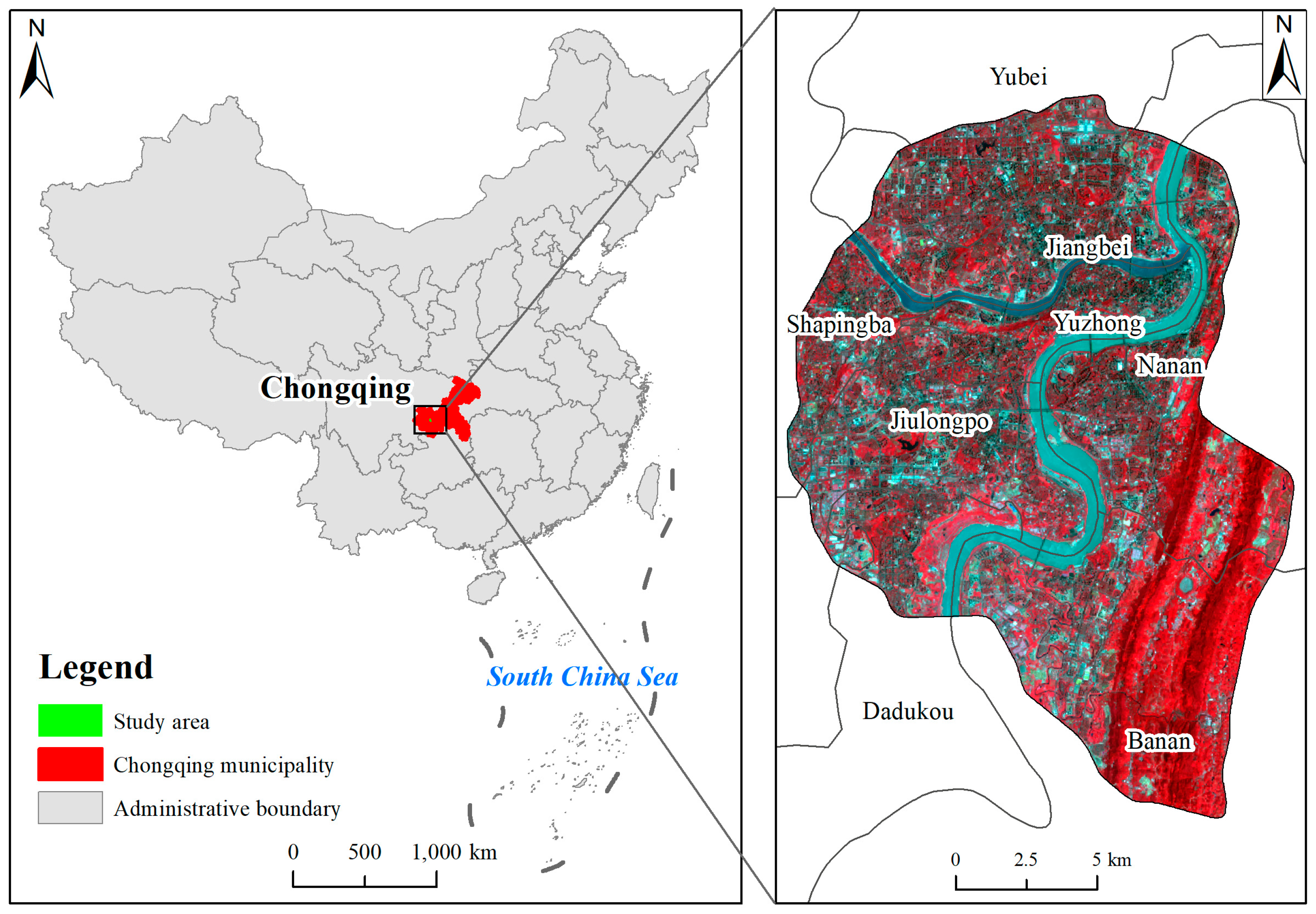
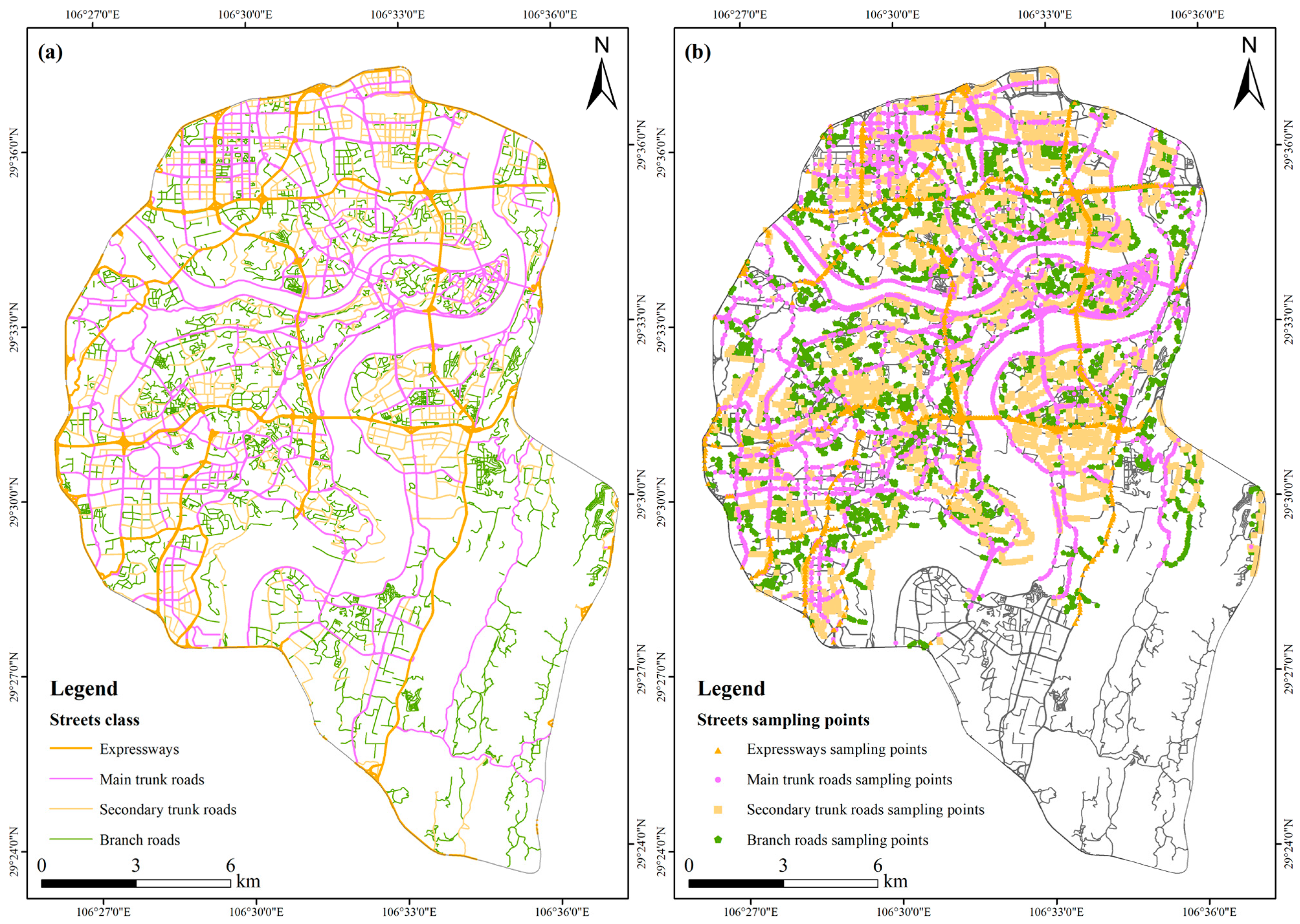

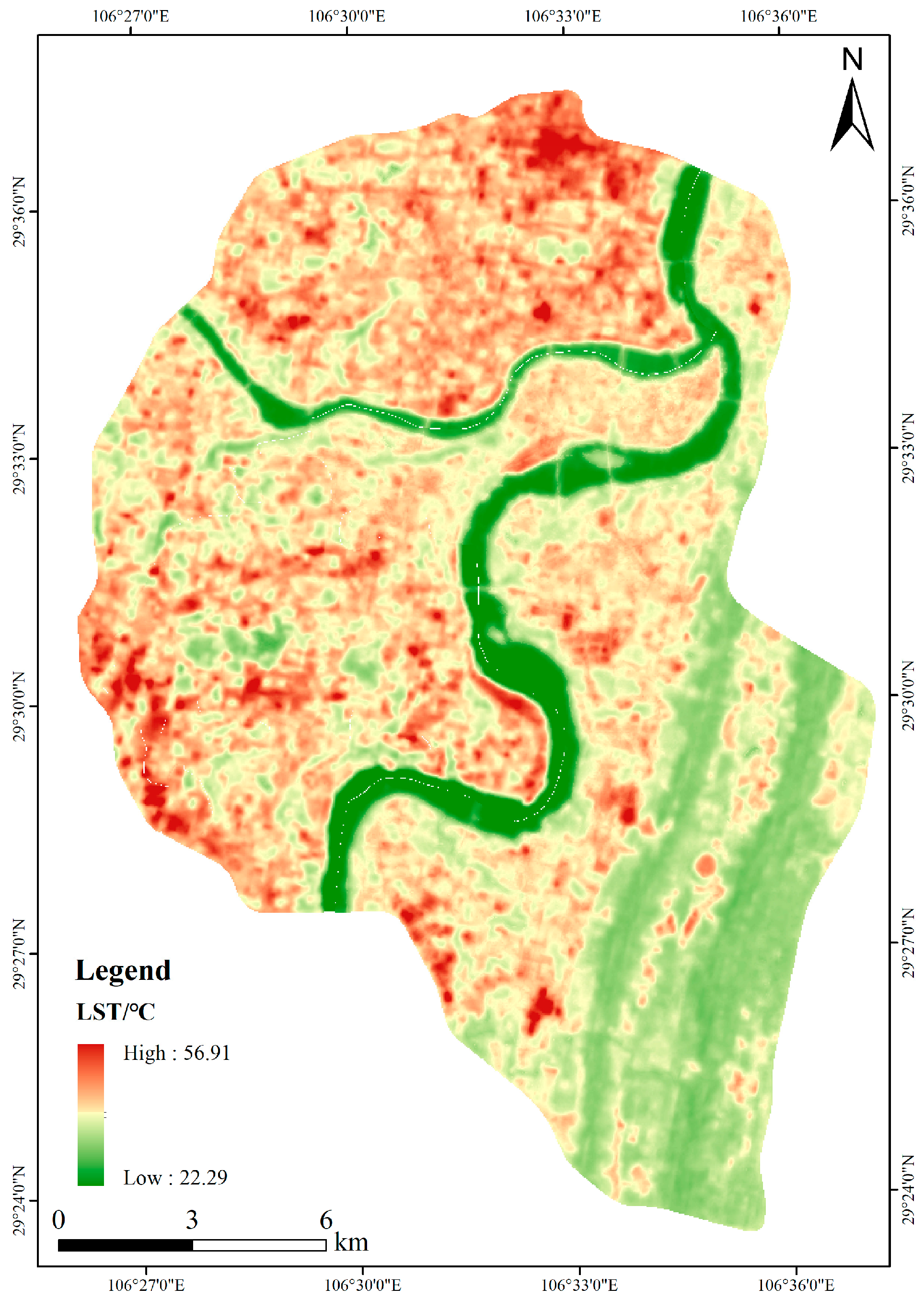


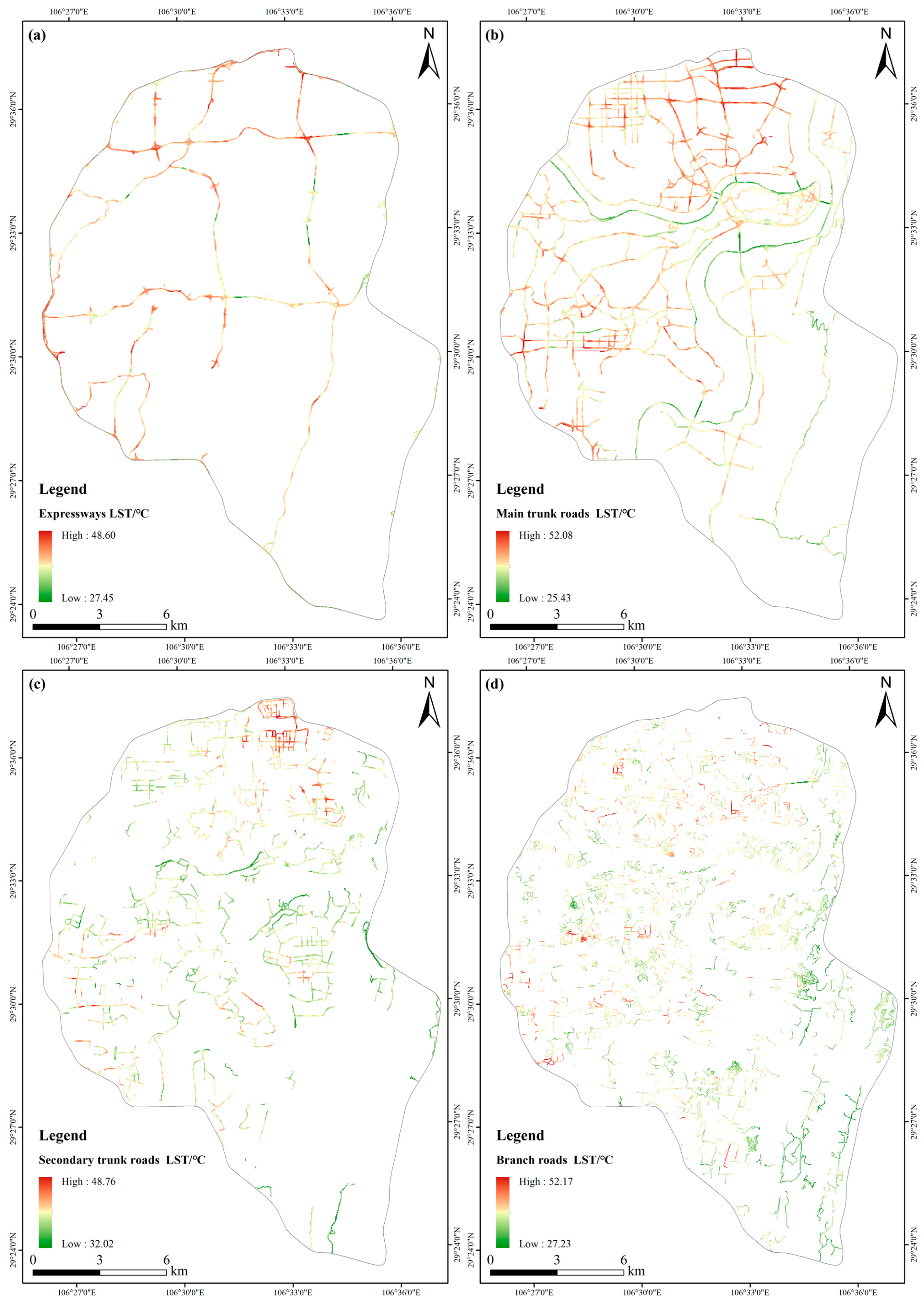


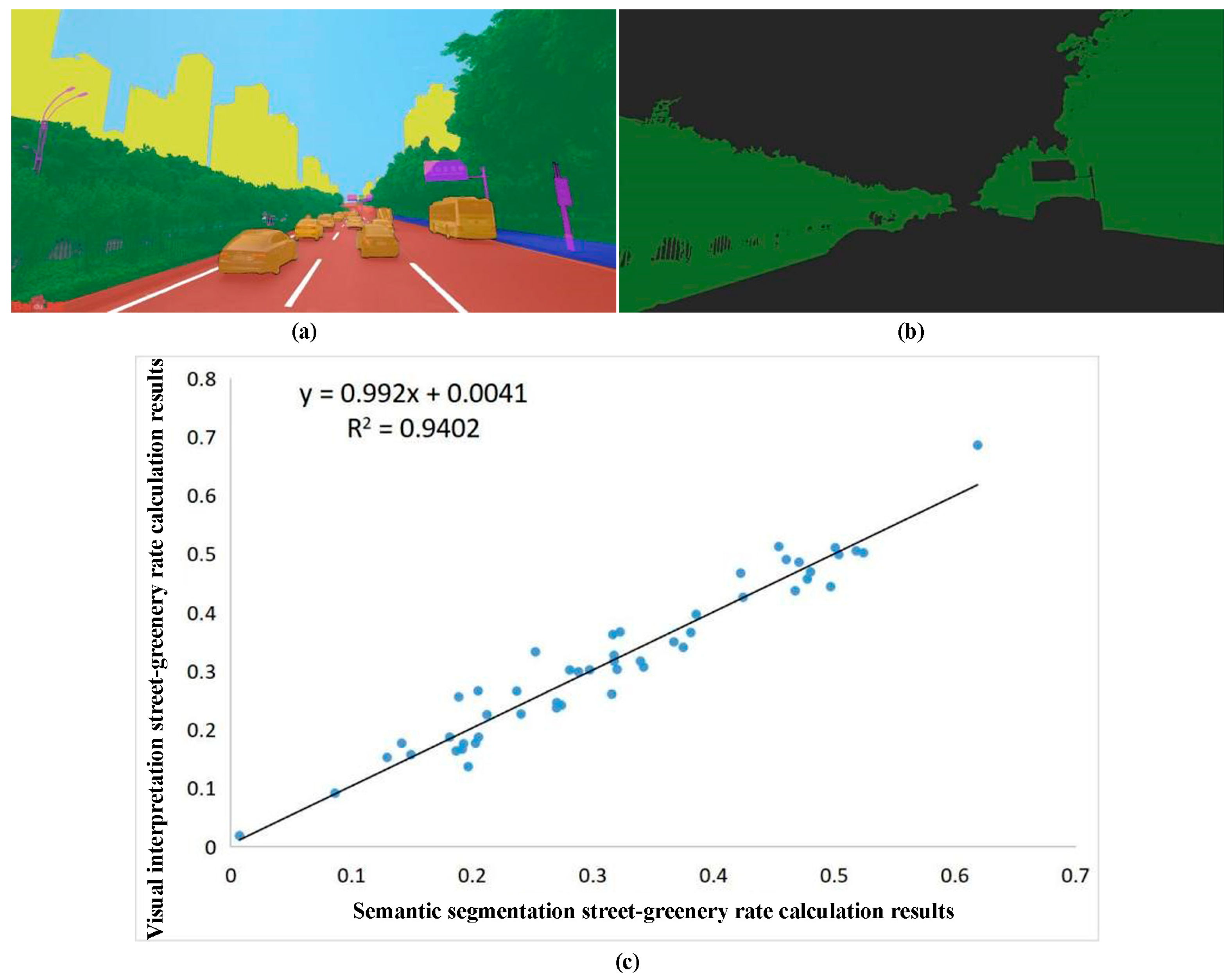


| Type | Sample |
|---|---|
| High-rise and high-density built-up area |  |
| Multi-rise and high-density built-up area |  |
| Low-rise and high-density built-up area |  |
| High-rise and low-density built-up area |  |
| Multi-rise and low-density built-up area |  |
| Low-rise and low-density built-up area |  |
| Forest area |  |
| Sand grassland and bare area |  |
| Hard ground area |  |
| Waterbody area |  |
| Block Type | Average Building Height/m | Pervious Surface Fraction/% | Building Density/% | Impervious Surface Fraction/% |
|---|---|---|---|---|
| High-rise and high-density built-up area | ≥30 | <10 | ≥20 | 40–60 |
| Multi-rise and high-density built-up area | 10–30 | <20 | ≥20 | 30–50 |
| Low-rise and high-density built-up area | <10 | <30 | ≥20 | 20–50 |
| High-rise and low-density built-up area | ≥30 | 30–40 | 5–20 | 30–40 |
| Multi-rise and low-density built-up area | 10–30 | 20–40 | 5–20 | 30–50 |
| Low-rise and low-density built-up area | <10 | 30–60 | 5–20 | 20–50 |
| Forest area | - | >90 | <5 | <10 |
| Sand grassland and bare area | - | >90 | <5 | <10 |
| Hard ground area | - | <10 | <5 | >90 |
| Waterbody area | - | >90 | <5 | <10 |
| Block Type | Street Type | Street Orientation | Pearson Correlation Coefficient | Sampling Points |
|---|---|---|---|---|
| High-rise and high-density built-up area | Expressway | South-north | −0.203 | 68 |
| East-west | −0.611 ** | 100 | ||
| Main trunk road | South-north | 0.003 | 535 | |
| East-west | −0.085 * | 531 | ||
| Secondary trunk road | South-north | −0.227 ** | 489 | |
| East-west | −0.136** | 463 | ||
| Branch road | South-north | −0.194 ** | 653 | |
| East-west | −0.060 | 381 | ||
| Multi-rise and high-density built-up area | Expressway | South-north | −0.360 ** | 59 |
| East-west | −0.067 | 20 | ||
| Main trunk road | South-north | −0.224 ** | 220 | |
| East-west | 0.007 | 160 | ||
| Secondary trunk road | South-north | −0.264 ** | 153 | |
| East-west | 0.022 | 158 | ||
| Branch road | South-north | −0.228 ** | 201 | |
| East-west | −0.273 ** | 112 | ||
| Low-rise and high-density built-up area | Expressway | South-north | / | 0 |
| East-west | / | 0 | ||
| Main trunk road | South-north | −0.916 ** | 9 | |
| East-west | / | 0 | ||
| Secondary trunk road | South-north | −0.813 | 3 | |
| East-west | / | 2 | ||
| Branch road | South-north | / | 1 | |
| East-west | −0.930 | 4 | ||
| High-rise and low-density built-up area | Expressway | South-north | −0.401 ** | 294 |
| East-west | −0.174 | 65 | ||
| Main trunk road | South-north | −0.253 ** | 931 | |
| East-west | −0.167 ** | 792 | ||
| Secondary trunk road | South-north | −0.256 ** | 578 | |
| East-west | −0.246 ** | 570 | ||
| Branch road | South-north | −0.335 ** | 431 | |
| East-west | −0.310 ** | 268 | ||
| Multi-rise and low-density built-up area | Expressway | South-north | −0.738 ** | 72 |
| East-west | −0.174 | 65 | ||
| Main trunk road | South-north | −0.705 ** | 412 | |
| East-west | −0.092 | 368 | ||
| Secondary trunk road | South-north | −0.709 ** | 246 | |
| East-west | −0.226 ** | 207 | ||
| Branch road | South-north | −0.727 ** | 167 | |
| East-west | −0.335 ** | 112 | ||
| Low-rise and low-density built-up area | Expressway | South-north | / | 0 |
| East-west | / | 0 | ||
| Main trunk road | South-north | −0.171 | 56 | |
| East-west | 0.073 | 23 | ||
| Secondary trunk road | South-north | −0.882 ** | 16 | |
| East-west | 0.673 ** | 14 | ||
| Branch road | South-north | −0.129 | 18 | |
| East-west | −0.664 ** | 16 | ||
| Forest area | Expressway | South-north | −0.620 * | 16 |
| East-west | −0.476 * | 19 | ||
| Main trunk road | South-north | −0.165* | 151 | |
| East-west | 0.186 | 64 | ||
| Secondary trunk road | South-north | −0.245 | 62 | |
| East-west | −0.356 ** | 52 | ||
| Branch road | South-north | −0.104 | 46 | |
| East-west | −0.493 * | 22 | ||
| Sand grassland and bare area | Expressway | South-north | 0.505 * | 16 |
| East-west | 0.840 | 3 | ||
| Main trunk road | South-north | 0.023 | 107 | |
| East-west | −0.008 | 69 | ||
| Secondary trunk road | South-north | 0.041 | 61 | |
| East-west | −0.792 ** | 25 | ||
| Branch road | South-north | 0.010 | 25 | |
| East-west | −0.349 | 16 | ||
| Hard ground area | Expressway | South-north | −0.326 ** | 122 |
| East-west | −0.478 ** | 104 | ||
| Main trunk road | South-north | −0.183 ** | 315 | |
| East-west | −0.054 | 165 | ||
| Secondary trunk road | South-north | −0.484 ** | 93 | |
| East-west | −0.474 ** | 94 | ||
| Branch road | South-north | −0.173 | 77 | |
| East-west | −0.325 | 36 |
Disclaimer/Publisher’s Note: The statements, opinions and data contained in all publications are solely those of the individual author(s) and contributor(s) and not of MDPI and/or the editor(s). MDPI and/or the editor(s) disclaim responsibility for any injury to people or property resulting from any ideas, methods, instructions or products referred to in the content. |
© 2023 by the authors. Licensee MDPI, Basel, Switzerland. This article is an open access article distributed under the terms and conditions of the Creative Commons Attribution (CC BY) license (https://creativecommons.org/licenses/by/4.0/).
Share and Cite
Wang, X.; Li, Z.; Ding, S.; Sun, X.; Qin, H.; Ji, J.; Zhang, R. Study on the Relationship between Urban Street-Greenery Rate and Land Surface Temperature Considering Local Climate Zone. Int. J. Environ. Res. Public Health 2023, 20, 3294. https://doi.org/10.3390/ijerph20043294
Wang X, Li Z, Ding S, Sun X, Qin H, Ji J, Zhang R. Study on the Relationship between Urban Street-Greenery Rate and Land Surface Temperature Considering Local Climate Zone. International Journal of Environmental Research and Public Health. 2023; 20(4):3294. https://doi.org/10.3390/ijerph20043294
Chicago/Turabian StyleWang, Xinyue, Zhengrui Li, Shuangxin Ding, Xiufeng Sun, Hua Qin, Jianwan Ji, and Rui Zhang. 2023. "Study on the Relationship between Urban Street-Greenery Rate and Land Surface Temperature Considering Local Climate Zone" International Journal of Environmental Research and Public Health 20, no. 4: 3294. https://doi.org/10.3390/ijerph20043294
APA StyleWang, X., Li, Z., Ding, S., Sun, X., Qin, H., Ji, J., & Zhang, R. (2023). Study on the Relationship between Urban Street-Greenery Rate and Land Surface Temperature Considering Local Climate Zone. International Journal of Environmental Research and Public Health, 20(4), 3294. https://doi.org/10.3390/ijerph20043294









